Brian Meert's Blog, page 130
February 1, 2018
4 Facebook Tips for Getting Creative with Vertical Video
 February 2, 2018
February 2, 2018Anna Hubbel

Gone are the days of creative limitation, when creators felt restricted by landscape or television formats for video. Now, you or your creative team can play within a vertical space, coming up with new, innovative ways to engage with consumers.
Play within a #vertical space by coming up with new, innovative ways to engage with consumers in #mobile video. #verticalvideo #facebooktips
Click To Tweet
The vertical video format is the most conducive to mobile experiences, as most consumers will be viewing your brand’s video on their smartphone devices. Additionally, according to Facebook Business, 65 percent of consumers consider brands that advertise with vertical video more innovative. Moreover, 79 percent of novice vertical video consumers prefer the vertical format and consider it more engaging.
Here are four tips Facebook Business offers for creating vertical video ads.
1. Use Height to Direct the Eye
Since your audience won’t be viewing your video from left to right, as with landscape videos, you can play around with different ways to direct their eyes. Whether it’s zooming in and out on different elements within your video, placing prominent elements center screen, or using contrasting colors to make those elements pop, there are countless creative ways to make a roadmap for your viewers.
https://www.advertisemint.com/wp-content/uploads/2018/01/vertical-video-ad-example-1.mp4
2. Try a Split Screen
Use a split screen to showcase your product in two different ways at the same time. Or use a split screen to tell a story in a unique and creative way. Making one portion of the screen larger than the other can also convey where you want your viewers to place the most attention in your message. There are various benefits of dividing up the vertical space of your video.
https://www.advertisemint.com/wp-content/uploads/2018/01/vertical-video-example-2.mp4
3. Have Fun with Animation
Bring your ideas to life through 2D, 3D, stop-motion, or motion graphics animations. Make the video watching experience fun for your viewers with action that flows top to bottom, bottom left to top right, or even bottom to top, whatever tells your story best. Animations can give life to the vertical space.
https://www.advertisemint.com/wp-content/uploads/2018/01/vertical-video-example-3.mp4
4. Try Type Overlays for Texture and Dimension
Type or text overlays can add texture and dimension to your vertical video. Adding this extra layer as a creative placement or element in your video helps make the content pop and introduces sophistication to your message.
https://www.advertisemint.com/wp-content/uploads/2018/01/vertical-video-example-4.mp4
In addition to catering your video creative to vertical formats, consider the findings that a recent Facebook study discovered regarding effective mobile video techniques.
The post 4 Facebook Tips for Getting Creative with Vertical Video appeared first on AdvertiseMint.
Facebook Releases Fourth Quarter Earnings Report
 February 1, 2018
February 1, 2018Anne Felicitas
 Photo courtesy of Entrepreneur.com
Photo courtesy of Entrepreneur.comFacebook releases its earnings report for the fourth quarter, revealing a drop in user time spent.
According to the report, time spent on Facebook dropped roughly 50 million hours every day, a figure which Tech Crunch estimates to be 2.1 minutes per user per day. The reason for the drop, according to CEO Mark Zuckerberg, is the reduction of viral videos in its platform.
“Already, last quarter, we made changes to show fewer viral videos to make sure people’s time well spent is well spent,” explained Zuckerberg during the earnings call. “In total, we made changes that reduced time spent on Facebook by roughly 50 million hours every day.”
Earlier this month, Zuckerberg announced that Facebook’s new News Feed algorithm will reduce organic reach from public entities such as businesses, organizations, and the media. Last year’s Russian interference during the 2016 presidential election and the proliferation of fake news on its platform precipitated this change.
Despite the drop in time spent, Facebook’s active users and ad revenue increased. Facebook’s daily active users are now at 1.40 billion, an increase of 14 percent year over year. It’s monthly active users also increased to 2.13 billion, another 14 percent year-over-year increase. By the end of December 31, 2017, Facebook’s ad revenue increased to $12.97 billion.
With the changes to News Feed, Zuckerberg hopes to make Facebook good for people’s well being and for society. In the next earnings report, investors will see whether this effort will reduce time spent, active users, and ad revenue.
The post Facebook Releases Fourth Quarter Earnings Report appeared first on AdvertiseMint.
January 31, 2018
How to Repurpose Your Blogs on Facebook
 February 1, 2018
February 1, 2018Danielle Kunkle, co-founder at Boomer Benefits
How to make the most of your blog posts. #bloggers #writers #blogging
Click To Tweet

Perhaps you’ve heard of the 80/20 rule when it comes to your content. You should spend about 20 percent of your time creating content and 80 percent of your time promoting it. But how many of us do it? It’s a shame if you don’t. Think of all those hours of hard work you put in researching, writing, and editing that epic blog post. It’s important that you share your genius with the world. Here are a few easy repurposing ideas to get the most mileage that you can out of every post you write.
First, Write Valuable (and Evergreen) Posts
Hopefully you are writing regularly for your blog because Google pays attention to how often you publish new content. The more often you post, the higher you rank on Google’s search results. However, you never sacrifice quality for quantity. You should put a lot of time and thought into making insanely useful posts that will bring incredible value to your readers. Bonus points for choosing evergreen topics, which are always relevant to readers, because that makes it easier to promote your posts all year round.
Here’s an example of a Medicare 101 post that I wrote for my own website. Notice the length, structure, and topic. Because it’s evergreen, I can republish it in the future.
If you can’t write posts with considerable depth and quality because of time constraints, then aim to write better posts less often. Consistency is better than frequency.
Schedule 12 Months of Visibility for Your Post
Whether you use your own content promotion calendar or a scheduling tool like Missinglettr, you need to post that stellar article multiple times over the next year. Organic reach of your posts on Facebook has been falling for some time, and Mark Zuckerberg’s recent comments promise more of the same. Since only a small percentage of your fans ever even see your post, it’s okay to republish that post several times over the next year.
Go Live
Although many people will read your article over the next year, not everyone who uses Facebook is a reader. That’s why, of course, video posts on Facebook have surged to all-time highs. Take the content from your blog post and go live on Facebook to talk about it. Some people will write a script for this, but I prefer to wing it because the nature of live video is that it’s okay to be unpolished. Talking about the topic on live video demonstrates to my viewers that I’m an expert on the subject. Going live will build your online authority as a thought leader in your niche or space.
Turn Posts into Images
Another great tactic is to pull several of the tips or quotes from your post and turn them into image posts. Let’s say your post involves 10 tips on writing a killer resume. Choose two or three of those tips and then use Canva or your favorite graphics software to make Facebook image posts (800 x 800 pixels) for each one. Be sure to include a small copy of your logo or your website URL for brand awareness. When you post the image on Facebook, be sure to include a link in your ad copy back to your original post. Images tend to generate lots of shares so get creative with them or use bold colors to make them stand out. Here’s an example of one we use frequently:
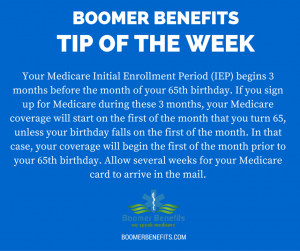
You can also do something similar with trivia or a poll around the blog content’s topic. Anything that generates engagement (likes, comments, shares) from your readers will keep it appearing in the News Feed more often.
Give these tactics a try and set your content up to be in front of readers time and time again. Soon you’ll experience the traffic benefits that Facebook can bring to your site.
Danielle Kunkle Roberts is the co-founder of Boomer Benefits, a licensed insurance agency that helps Baby Boomers navigate their entry into Medicare.
The post How to Repurpose Your Blogs on Facebook appeared first on AdvertiseMint.
How to Push Customers through the Sales Funnel on Facebook
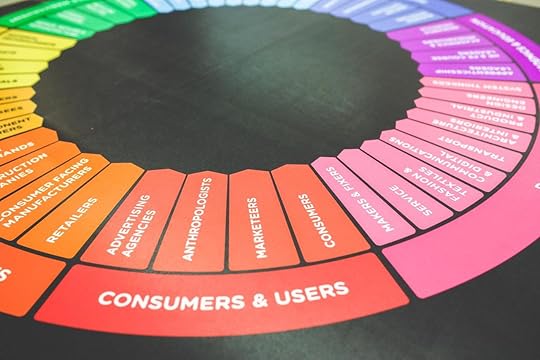 January 31, 2018
January 31, 2018Marijana Kay
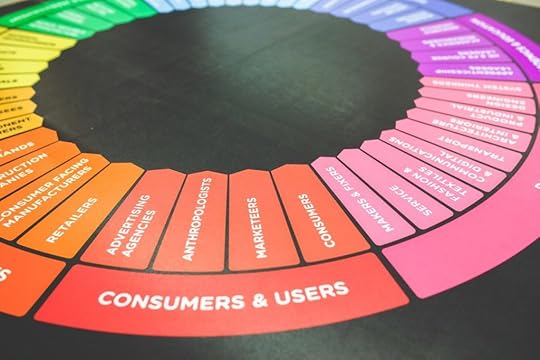
With Facebook now having more than two billion users, there are many opportunities for businesses to grow on the platform. Although your first thought might be the drop in organic reach for brands and publishers on News Feed, don’t forget the power of advertising on Facebook. Because of its advertising features and options including objectives, targeting, and segmenting, you can reach your ideal audience right where they are and right where they expect to see you.
To turn users into loyal customers, push them through the three stages of the sales funnel:
Top of the funnel: the awareness stage where customers are looking for answers, resources, and education.
Middle of the funnel: the consideration or evaluation stage where customers heavily research whether or not your product or service is a good fit for them.
Bottom of the funnel: the purchase or conversion stage where customers look for final validation to make their purchase.
By guiding your audience through the funnel, you can ensure the highest return on investment no matter where they are right now. Let’s break each of these stages down.
Top of the Funnel: Social Discovery
In case you’re inclined to garner more purchases, the one and only focus of your ads, think about this: Facebook users don’t log in to the platform to be sold. Instead, they come so they can socialize. This includes liking other people’s updates, commenting, and messaging.
 Photo courtesy of Aaron Zakowski
Photo courtesy of Aaron ZakowskiFor you, this means you need to provide them with content they will want to like, comment, or share, so instead of selling, you will see the highest engagement if you educate, engage, and entertain. The ideal way to do this is with video.
Because video is changing the way consumers shop, think about what they would enjoy seeing from you and what they could engage with. There are two main ways you can work with video at this stage of the funnel: you can post it organically or you can increase its reach by either boosting a Facebook post or creating a video ad. As customers watch your video, Facebook gathers data about those customers who you can take into the next stage of the funnel.
Middle of the Funnel: Consideration and Segmentation
Once your video has been published for some time, you’re ready to build your segmented audiences. The best thing about using video on Facebook is not only can you create specific groups (called Custom Audiences) you can advertise to, but you can also use the Lookalike Audiences to build groups that are likely to be interested in you because they’re similar to that first group that’s already engaging with you.
To get started on your segmented audiences, go to your Audiences tab in Business Manager and select Custom Audience from the Create Audience dropdown menu. Then choose Engagement, choose Video, and select the video you used as the top of the funnel content. The best part here is you can create multiple audiences based on how much of the video your customers watched.
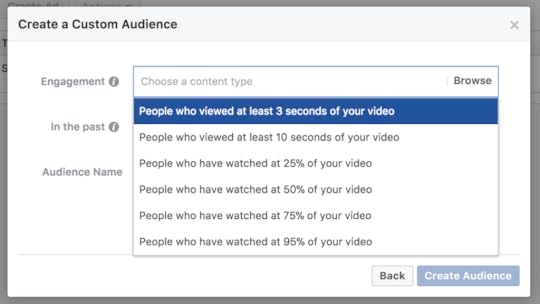 Segment an audience based on view duration.
Segment an audience based on view duration.Once you create your audience, you can go ahead and select Lookalike Audience from that same dropdown menu mentioned earlier. After you’ve selected the audience you want to replicate, you can add countries and the audience size for your Lookalike Audience.
Now that you’ve defined your audiences for the middle of the funnel stage, your next step is to make them your target audience for content that fits this consideration stage (also called evaluation stage). Remember, you’re now advertising to audiences already familiar with you, so you want to use this opportunity to serve them in-depth content that proves you’re the expert in your industry. Content like long-form blog posts, webinars, free trials and live demos can produce brilliant results because they further build up your audience’s awareness of you and increase trust in your authority.
Bottom of the Funnel: Nudge toward Conversion
At the final stage of the funnel, the Facebook Pixel is your strongest asset. With it, you can track and analyze the audience that engaged with your middle-of-the-funnel content and retarget them with even more relevant Facebook ads.
The audience that has come this far through your sales funnel now knows what you can do for them. They watched your video, landed on your website, consumed the content you served them there, and signed up for additional free value you offered—they now need a final nudge from you.
Because of the Facebook Pixel, you can target your audiences with Dynamic Product ads and Multi-Product ads, showing them products based on their browsing history on your website or the products they’ve added to their shopping cart.
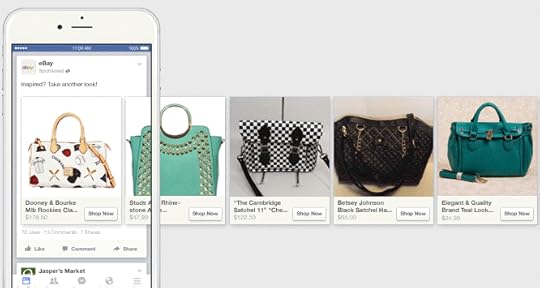 An example of a Dynamic Product Ad
An example of a Dynamic Product AdOther options include retargeting these engaged audiences with offers like discounts, vouchers, or free shipping. This works because they’ve shown interest in your products or services, and this is a gentle way to incentivize them to take that final step and complete the purchase.
The three stages of the sales funnel are the steps you need to take to turn your ideal audience from stranger to paying customer.
Marijana Kay is a freelance writer and content strategist working with SaaS and marketing brands on their content marketing strategy. She creates long-form, actionable content that grows her clients’ visibility, authority, and revenue. Marijana is also a judge for marketing industry awards, and she hosts a content marketing podcast called Content Love.
The post How to Push Customers through the Sales Funnel on Facebook appeared first on AdvertiseMint.
Adhering to Advertising Principles, Facebook Bans Bitcoin Ads
 January 31, 2018
January 31, 2018Anne Felicitas
@facebook bans #bitcoin ads. #cryptoccurency #binaryoptions #ico #money #investment #investing
Click To Tweet

During a time of heightened interest in cryptocurrency, especially in bitcoin, Facebook bans cryptocurrency ads.
Rob Leathern, Facebook’s product management director, revealed Facebook’s new advertising policy on Tuesday.
“We’ve created a new policy that prohibits ads that promote financial products and services that are frequently associated with misleading or deceptive promotional practices, such as binary options, initial coin offerings and cryptocurrency,” said Leathern in a Facebook Business post.
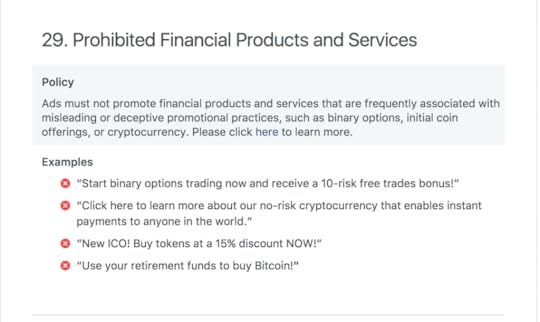 Facebook updates its advertising policy
Facebook updates its advertising policyEnforcement of the new policy will now take effect, applying to ads that are served on Facebook, Audience Network, and Instagram. According to a Facebook representative when asked for comments, both active and new cryptocurrency ads will be disapproved.
According to Leathern, Facebook’s move abides by its advertising principles that protect Facebook users from scams and misleading or deceptive ads. Because many companies advertising binary options, ICOs, and cryptocurrencies are not currently in good standing, the social network decided to ban all cryptocurrency ads.
In fact, earlier this week, a cryptocurrency project built on Ethereum called Prodeum disappeared with investors’ money, and earlier this month, a long-suspected Ponzi scheme, BitConnect, was forced to cease operations by authorities in Texas and North Carolina.
James Altucher, an American hedge fund manager and Venture capitalist who educates people on Bitcoin, approves of Facebook’s decision to ban cryptocurrency ads.
“Kudos to Facebook for trying to clean up all of the garbage out there,” said Altucher in an email interview with Recode. “This [Bitcoin] is an enormous opportunity, but, like any new financial opportunity, the schemers and crooked charlatans are having a field day.”
Because Facebook currently has more than five million advertisers, it may not apprehend all deceptive ads appearing on its platform. Facebook encourages users to report ads that they find suspicious.
The post Adhering to Advertising Principles, Facebook Bans Bitcoin Ads appeared first on AdvertiseMint.
Marketers Should Look at Amazon as a Rising Advertising Platform
 January 31, 2018
January 31, 2018Anna Hubbel
Marketers should look to @Amazon as a rising platform for advertising. #digitaladvertising #AmazonAds
Click To Tweet Photo Courtesy of AdAge
Photo Courtesy of AdAge
Amazon is known for having just about everything for the average consumer: variety, video, music, great prices, fast shipping, an efficient voice assistant device, and much more. The e-commerce site also offers a popular platform for businesses to sell their own products to a limitless audience.
Jeff Bezos, the prestigious founder of Amazon, has kept his cloud services business focused on functionality and exceptional products and services, rather than advertising—until now.
Amazon’s New Focus on Advertising

According to Ad Age, generating advertising revenue is on the horizon for the e-commerce giant. Visitors to the site may have noticed the subtle increase in sponsored products featured in the search results. This tactic serves to tempt advertisers to get a prominent spot by purchasing ads through Amazon.
Ad Age says that advertising on websites and mobile devices will make up 50 percent of all US ad spending by the year 2021. Although Amazon only generated $1.7 billion in ad revenue last year, it is beginning to take center stage in the advertising market from the perspectives of major companies such as Procter & Gamble. According to Ad Age, Omnicon Group created an Amazon advertising strategy in November.
In addition, big grocery brands and big packaged-goods companies, businesses that invest a sizeable $225 million on advertising and in-store promotions yearly, have been transitioning to Amazon. With the increasing shift to digital shopping, it comes as no surprise that these companies are willing to invest in online advertising, and Amazon is a guaranteed platform for successful results.
Attracting 180 million monthly US visitors, Amazon is the perfect hub for advertising exposure.
“Similar to the candy and magazine racks, which are the most valuable space in the store, Amazon is the most valuable space on the web because you are at the very bottom of the funnel,” Scott Galloway, a marketing professor at New York University’s Stern School of Business and author of The Four: The Hidden DNA of Amazon, Apple, Facebook and Google, said in an Ad Age article. “Not only are people about to make a purchase, but you know what’s in their basket. It’s hard to imagine a more target-rich medium than Amazon or robust offering.”
Additionally, marketers who advertise through Amazon have the benefit of real-time insights for campaign performance. “You can put a sale on Amazon and see relatively quickly if there’s an uptick,” Neil Ackerman, a former Amazon and Mondelez executive now leading innovation for Johnson & Johnson’s global supply chain, said in the same Ad Age article. “Amazon realizes it can use this to grow ad revenue, and it can charge more because it provides instant results.”
Ad Age says Amazon is expanding its advertising to more than just sponsored search results, investing more into the ad aspect of its business. Throwing this giant company into the competitive advertising mix of Facebook and Google could be a major game changer.
The post Marketers Should Look at Amazon as a Rising Advertising Platform appeared first on AdvertiseMint.
New Data Shows Drop in Time Spent on Publisher Sites in 2017
 January 31, 2018
January 31, 2018Anna Hubbel
 Photo Courtesy of Facebook Media
Photo Courtesy of Facebook MediaAs if the emphasis on fake news wasn’t enough for news publishers last year, recent data uncovered by Taboola indicates that US consumers’ time spent on publisher sites dropped in 2017.
New data indicates that US consumers' time spent on #publisher sites dropped in #2017. #mediastudies #fakenews
Click To Tweet
According to Emarketer, the average amount of time spent on publisher sites began at 2.09 minutes in the first quarter. But after a very slight rise in Q2, the average session dropped again and eventually landed on 1.90 minutes in Q4.
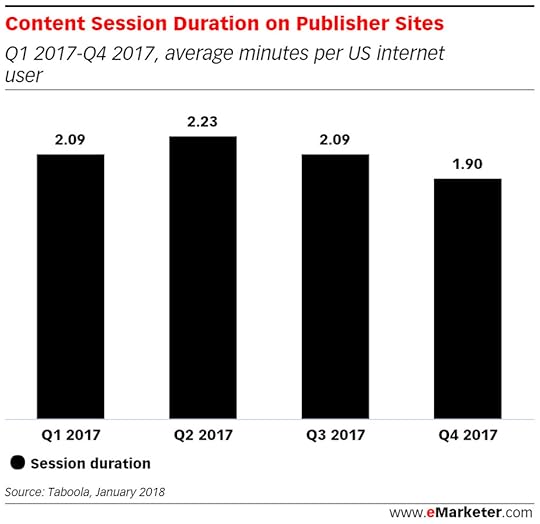 Photo Courtesy of eMarketer
Photo Courtesy of eMarketerIt comes as no surprise that Emarketer also reported that consumers spent more time reading news content on social media platforms last year. So it was only natural that publishers fell in line with that pattern by presenting news through social media.
Difference in Devices
Taboola also broke down its findings based on device. Data indicated that users spent an average of 1.90 minutes when visiting a publisher site on their smartphone. However, the average was higher, at 2.62 minutes, when users were on their desktops.
Interestingly, the average time spent rose for tablet usage in 2017, from 1.81 minutes in Q1 to 1.92 minutes in Q4.
What Publishers Need to Do
Rather than using social media as a news distribution channel, if publishers want to drive traffic to their sites, they may have to tweak their strategy enough to drive that traffic. Otherwise, consumers are only going to view the content that publishers are putting out there without leaving their social feed, which does little to progress in the business sense. One of the many ways media publishers can drive traffic to their sites is by capitalizing on the rise of video engagement.
The post New Data Shows Drop in Time Spent on Publisher Sites in 2017 appeared first on AdvertiseMint.
January 30, 2018
WhatsApp Launches an App for Business Owners
 January 30, 2018
January 30, 2018Jesica Schmidt

Networking is half the battle when expanding a customer base. WhatsApp’s new business app helps business owners grow their companies and make connections. This app, called WhatsApp Business, is similar to Facebook Messenger and Skype: it helps business owners connect with their customers.
WhatsApp Business exists as its own app because business accounts are fundamentally different from user accounts. Unlike user accounts, business accounts have business profiles with information such as the business description, email, and location address. Business accounts, once set up and verified, are added to an easily accessible list. Once a user finds a business profile from the list, the app guides them to highlighted information about the company.
WhatsApp Business makes communication easy with instant messaging and calling. The app includes multimedia messaging, free calls, free international messaging, and group chats. It also offers customizable quick replies and accessibility to users’ statistics. Once installed, WhatsApp’s web application allows the user and the business owner to reply directly from their browsers. The app also allows users to report spam, block numbers and companies, and have full control over the messages they read.
Users who have two separate mobile numbers for home and work can have two accounts. WhatsApp Business and WhatsApp Messenger are both compatible and available on the same device, registered under different numbers. The app is also compatible with landline numbers: business owners only need to click the “call me” option and proceed.
Both the desktop and the app versions are free, eagerly welcoming inexperienced users. Although currently available to small business owners, WhatsApp plans to expand to larger businesses and global customers. WhatsApp will soon reach out to Airlines, banks, e-commerce sites, and other companies with a worldwide customer base.
The post WhatsApp Launches an App for Business Owners appeared first on AdvertiseMint.
The Best Marketing Strategy for Each Social Media Platform
 January 30, 2018
January 30, 2018Bart Mroz, co-founder and CEO of SUMO Heavy

Seventy percent of all US adults use at least one social media network. While most brands agree that social media is a critical channel, many aren’t leveraging the strengths that are unique to each platform, and the opportunities to leverage social media to raise brand awareness and generate revenue are immense.
The leading social networks—Facebook, Twitter, Instagram, Pinterest, and Snapchat—vary widely in their membership makeup, culture, and look and feel. Although the networks differ, brands can leverage the strengths that are unique to each social media platform and capitalize on a particularly strong feature.
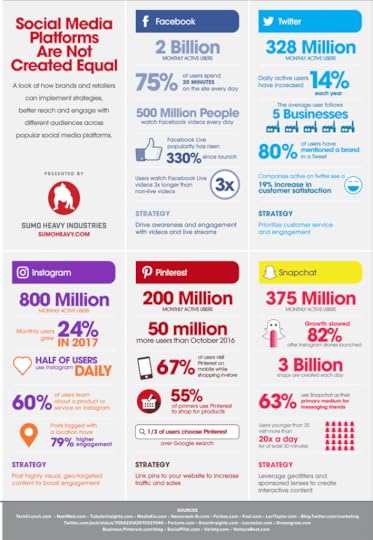
Although other platforms have entered the scene, 41 percent of Millennials use Facebook every day, and the platform has over 2 billion users, making it still the number one channel.
Facebook Live is a hot new medium that’s giving brands new modes to engage consumers and sell products. Users devour live video, watching a live stream three times longer than recorded video. In fact, Facebook Live’s popularity has risen 330 percent since it launched in 2016, and over 500 million people watch Facebook videos every day. With the new Facebook Watch feature, giving users access to a wide range of shows, the social network could attract more users.
For brands, the promotional possibilities via live streaming video are vast. Brands should focus on Facebook Live for ads, events, campaigns, product launches, and demonstrations to actively engage with their customers and drive brand awareness.
Twitter has made itself the go-to customer service channel. The average user follows five businesses, and 80 percent have mentioned a brand in a tweet, so it’s a great platform to connect with customers. Because customer service on Twitter is a public feed, it is a chance to show customers that your organization is caring and responsive.
Brands should have a dedicated Twitter handle for customer service because brands who do so get a response ten times more than brands who don’t. Moreover, brands that use Twitter as a social care channel see a 19 percent increase in customer satisfaction. For some good examples of how to conduct customer service on Twitter, see Amazon’s customer service (@AmazonHelp) and Hilton Hotel’s customer service (@HiltonHelp).
Instagram is an extremely popular platform for Millennials and Gen Zs. More than 60 percent of Instagram users are between the ages of 18 and 29, making Instagram a natural fit for youth-oriented brands and products. For example, Sephora and Nike have been successful in marketing to Millennials by using Instagram to post visually stunning photos that clearly reflects brand identity and draws users in. As a result, Nike has become the 19th most followed account while Sephora has increased its engagement rate and now boasts nearly 13 million followers.
Because posts tagged with locations have 79 percent higher engagement, and because 60 percent of users learn about a product or service from Instagram, brands should leverage visually rich platforms like Instagram to best showcase their product line. Additionally, brands should post highly visual, geo-targeted content to boost engagement.
Pinterest is a widely popular platform, and Millennials use it just as much as Instagram. Although 80 percent of Pinterest users are women, 40 percent of new users are men, showing the platform is slowly becoming more diverse.
Fifty-five percent of pinners use Pinterest to shop for products, and one-third of users choose Pinterest over Google search. Users browse with the intent to buy, making it an essential social media platform for many brands. When the goal is to drive traffic to your website, Pinterest is one of the best networks for that purpose. To increase traffic and sales, link pins to your website.
Snapchat
Snapchat is the go-to among Millennial and Gen Z users. It reaches 41 percent of all 18-to 34-year olds in the US each day, and 71 percent of users are under the age of 34. (However, note that growth slowed 82 percent after Instagram stories launched.) If brands want to implement interactive content with a younger audience to increase brand awareness, they can use Snapchat.
Interactive features like geotags and lenses are a great way to increase brand exposure and engagement. For example, Puma uses social media to drive awareness around big product and campaign launches. It has successfully used Snapchat for some of its most visible projects, unveiling its recent Fierce campaign featuring Kylie Jenner. It also leveraged Snapchat’s geotag filters to engage with their audience when attending Rihanna’s concerts. Like Puma, leverage geofilters and sponsored lenses to create interactive content.
The potential for reaching and serving customers via social media continues to expand. Social media networks are continually adding new features, so it is imperative to keep up with the changes, master new techniques, and integrate new engagement and personalization approaches into your social campaigns.
Bart Mroz, a serial entrepreneur with over a decade of business management and technology experience, is the co-founder and CEO of SUMO Heavy. A thought leader and a founding partner of multiple consulting companies, Mroz was published in Internet Retailer and AdExchanger. Follow Bart Mroz on Twitter.
The post The Best Marketing Strategy for Each Social Media Platform appeared first on AdvertiseMint.
5 Best Practices for Protecting Yourself Against Cyber Breaches
 January 30, 2018
January 30, 2018Anna Hubbel

Although digital technology is invaluable in today’s marketing game, its data collection abilities also make it susceptible to cybercrime. Cybersecurity has become increasingly important and should be a priority in protecting your brand. Here are some best practices to protect your business and your assets from digital breaches.
Use cybersecurity best practices to protect your business and your assets against digital breaches. #cybersafety #brandprotection
Click To Tweet
1. Closely Monitor Financial Statements
Although this practice may seem less market focused, if a hacker gets a hold of your password information through any platform or media channel, your business’s finances are also at risk, especially if you use the same or a similar password for all of your accounts.
Keep a close eye on all of your business’s financial statements so that you are able to catch any suspicious activity right away.
2. Create Strong Passwords
The more complex your password is for all of your digital business dealings, the better. Use a mix of capital and lowercase letters, as well as interject a special character and a number or two.
If a login has requirements or suggestions for what characters to use in your password, follow those requirements in a way that makes your password the strongest it can be. Also, avoid making passwords that use parts of your name, birthday, Social Security number, or anything else that may be personal. These types of passwords are easier to hack.
Hackers have a more difficult time retrieving passwords if they’re strong, so this is an important practice.
3. Update Your Passwords Regularly
Schedule a repeated reminder to update your passwords every so often. Regularly changing your passwords prevents hackers from having time to breach your digital security.
4. Invest in Identity Protection
Use an identity protection service to prevent breaching malware from stealing your personal information. It’s worth paying a fee to protect all of your information, data, and, subsequently, your brand.
5. Educate Yourself
Learning about cybersecurity sounds intimidating, but it’s vital to understand the connections between devices and data in order to protect your marketing ecosystem. According to eMarketer, marketing professionals don’t show as much concern as they should about their cybersecurity. Make it a priority to at least know the basics of your digital and data connections so that you know what resources will best protect your business from a cyber breach.
The post 5 Best Practices for Protecting Yourself Against Cyber Breaches appeared first on AdvertiseMint.



